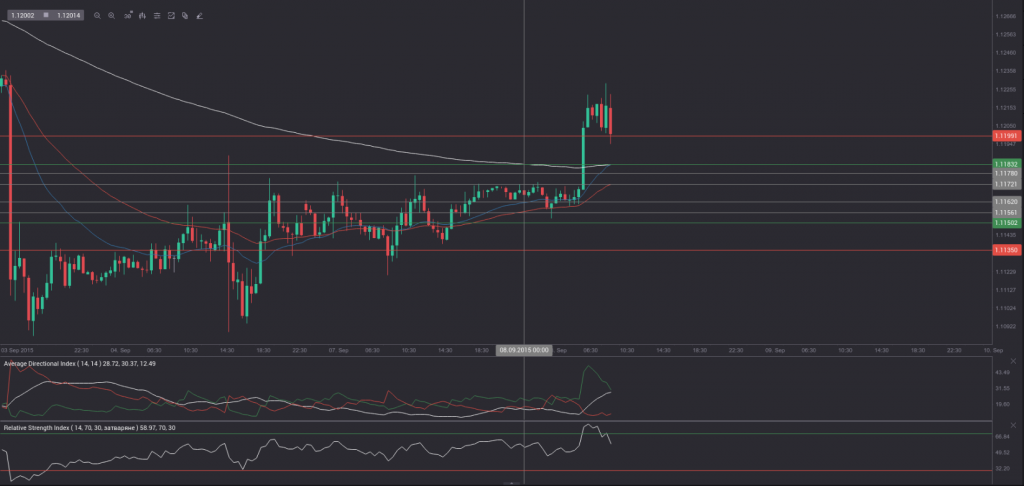Yesterday’s trade saw EUR/USD within the range of 1.1120-1.1178. The pair closed at 1.1167, gaining 0.11% on a daily basis and extending gains from Friday.
According to Binary Tribunes analysis on historical volatility, the average intraday volatility for the pair was 1.181% in August, or the highest since June, when average volatility was estimated at 1.383%. The June volatility has also been the highest one within the period January 2013-August 2015. At the same time, the average daily volatility for EUR/USD was 1.277% in August, or the highest one since June. Back then the average daily volatility was estimated at 1.463%, or the highest one within the period January 2013-August 2015.
At 6:49 GMT today EUR/USD was gaining 0.33% for the day to trade at 1.1207. The pair overcame the upper range breakout level (R4), as it touched a daily high at 1.1229 at 6:29 GMT.
Today the cross may be influenced by a number of macroeconomic reports as listed below.
Fundamentals
Euro area
Gross Domestic Product – final estimate
The seasonally adjusted final Gross Domestic Product in the Eurozone probably expanded at an annualized rate of 1.2% during the second quarter of 2015, according to market expectations. If so, it would match the preliminary estimate, reported on August 14th and would also be the fastest annual rate of growth since Q3 2011, when the region’s GDP expanded 1.4%. In Q1 economy of the Euro area grew at a final 1.0%, which came in line with the preliminary estimate.
The final GDP during Q2 compared to the first quarter probably showed a 0.3% expansion, experts project. If so, it would match the preliminary estimate. In Q1 the region’s economy expanded 0.4%.
The GDP growth for the area’s leading economies fell short of expectations in Q2. The German economy expanded 0.4%, against expectations of 0.5% growth rate. Italy posted a 0.2% growth, below forecasts of 0.3%. The Dutch GDP rose 0.1%, again below the median estimate of 0.3%. French economy registered no growth, while expectations pointed to a 0.2% expansion. Spanish GDP, on the other hand, surged 1% in Q2, which has been the most significant quarterly rate in over eight years, according to the report by Eurostat.
In case economic growth in the single currency zone exceeded expectations, this would have a strong bullish effect on the euro. Eurostat is expected to release the final GDP report at 9:00 GMT.
United States
Consumer Credit
The money amounts, borrowed by consumers decreased to USD 18.00 billion in July, according to market expectations, from USD 20.74 billion in June. The latter has been the largest amount borrowed since July 2014, when a figure of USD 21.61 billion was reported. Given the current state of the economy, a higher-than-expected amount borrowed is usually considered as dollar positive, as it implies a potential increase in consumer spending and accelerated growth, respectively. The Board of Governors of the Federal Reserve is to release the official numbers at 19:00 GMT.
Bond Yield Spread
The yield on German 2-year government bonds went as high as -0.213% on September 7th, or the highest level since September 3rd (-0.197%), after which it slid to -0.222% at the close to add 1.3 basis points (0.013 percentage point) on a daily basis. It has been the first gain in the past three trading days.
The yield on US 2-year government bonds climbed as high as 0.717% on September 7th, after which it closed at the exact same level to add 0.008 percentage point for the day.
The spread between 2-year US and 2-year German bond yields, which reflects the flow of funds in a short term, shrank to 0.939% on September 7th from 0.944% on September 4th. The September 7th yield spread has been the lowest one since September 3rd, when the difference was 0.928%.
Meanwhile, the yield on German 10-year government bonds soared as high as 0.689% on September 7th, after which it slid to 0.674% at the close to appreciate 1 basis point (0.01 percentage point) compared to September 4th. It has been the first gain in the past four trading days.
The yield on US 10-year government bonds climbed as high as 2.151% on September 7th, after which it closed at the exact same level to add 2 basis points (0.02 percentage point) compared to September 4th. It has been the first gain in the past three trading days.
The spread between 10-year US and 10-year German bond yields widened to 1.477% on September 7th from 1.467% on September 4th. The September 7th yield difference has been the largest one since August 20th, when the spread was 1.488%.
Daily and Weekly Pivot Levels
By employing the Camarilla calculation method, the daily pivot levels for EUR/USD are presented as follows:
R1 – 1.1172
R2 – 1.1178
R3 (range resistance – green on the 30-minute chart) – 1.1183
R4 (range breakout – red on the 30-minute chart) – 1.1199
S1 – 1.1162
S2 – 1.1156
S3 (range support – green on the 30-minute chart) – 1.1150
S4 (range breakout – red on the 30-minute chart) – 1.1135
By using the traditional method of calculation, the weekly pivot levels for EUR/USD are presented as follows:
Central Pivot Point – 1.1188
R1 – 1.1291
R2 – 1.1434
R3 – 1.1537
S1 – 1.1045
S2 – 1.0942
S3 – 1.0799






